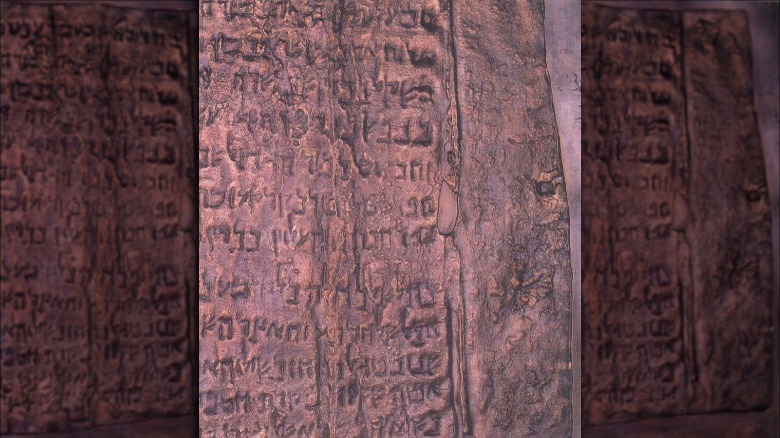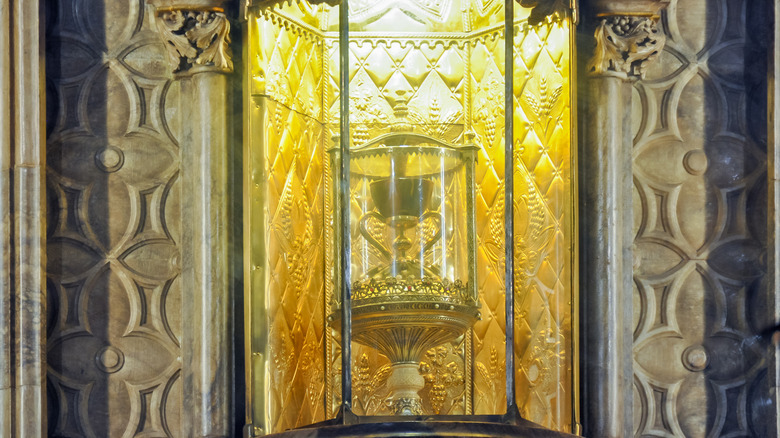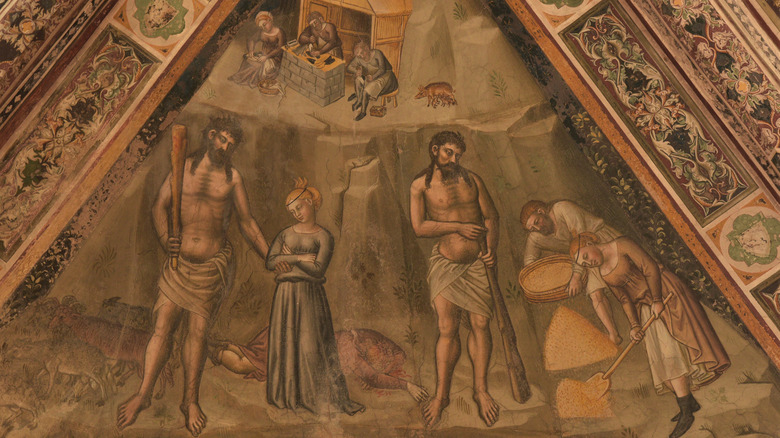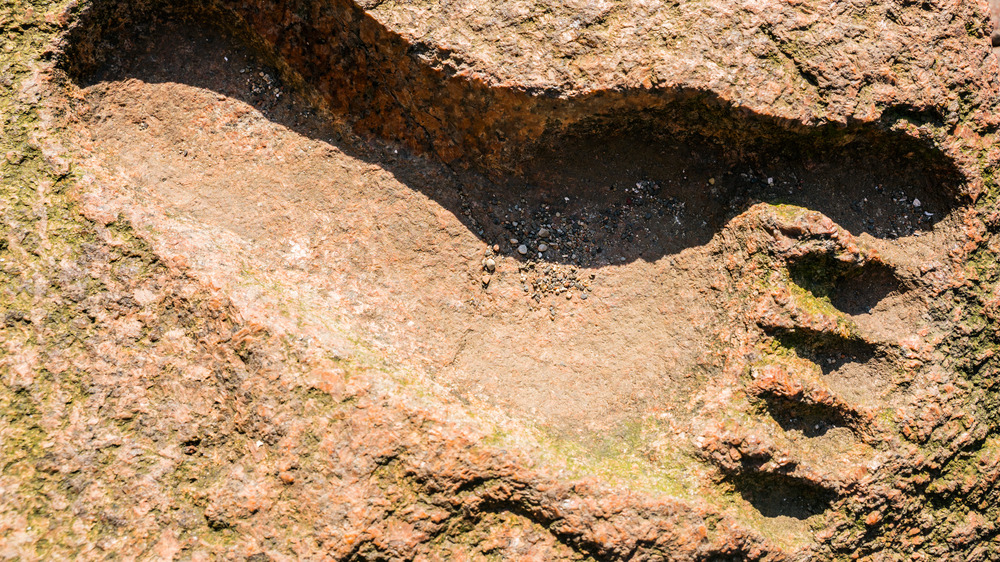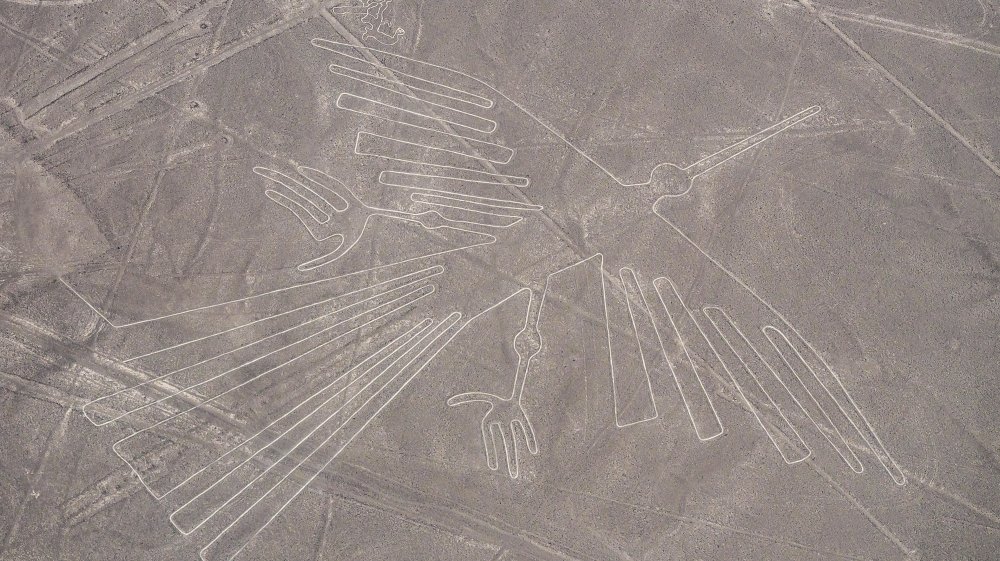
Christian Relics That Are Still Missing
The veneration of relics in Christianity, specifically Catholicism, is a fascinating piece of faith. According to Vice, religious historians actually know exactly when the adoration of things like saints’ body parts began — with a Syrian bishop named Polycarp. Polycarp was teaching this new-fangled religion called Christianity way back in the second century, and when he refused to stop at the behest of some very insistent Romans, they did what Romans tend to do when they’re told “No,”: They tied him up and set him on fire.
A wind kicked up, though, and Polycarp didn’t burn. Onlookers took that as a sign that he was protected by God, but he was only protected so much, because that’s when the Romans just drew their swords and chopped him to pieces. The faithful gathered the pieces of Polycarp, and the first relics were created.
Today, relics are still an important part of Catholicism: An altar can’t be consecrated without one, and the amount of controversy relics have caused over the centuries is enough to fill dozens of books. While there’s a ton of relics out there — including, for example, multiple skulls of St. John the Baptist — some of the biggest Biblical artifacts are still missing.
What's the real story behind the Veil of Veronica?
Assembling the stories of any religion is tricky business, and the Veil of Veronica is one of those odd-one-out sorts of tales. Christianity researcher John Iannone — who has been involved in research into the Shroud of Turin — did a deep dive into the story of Veronica.
The story seems to be a mash-up of a few different incidents, but the one featured on the sixth of the 14 Stations of the Cross depicts a woman who took pity on Christ as he made his way to Golgotha. She wiped the blood and sweat from his face, and Christ’s features were said to have been permanently imprinted on the veil. The story doesn’t come from Biblical sources like the New Testament, but Iannone suggests it still holds some veracity.
The veil itself was said to have been given to the Apostle John, and turned up in Constantinople. By 1199, there are written mentions of the relic being in Rome, but during the 16th and 17th century construction around St. Peter’s Basilica, the veil disappeared. It was said to have been stolen over and over again, and no one’s really sure what happened to it. Two places claim to have the veil — Rome and Manoppello — but there’s doubts around both, with speculation that they’re actually medieval replicas. Iannone ultimately comes to the conclusion that the Vatican definitely doesn’t have it, and while it may be in Manoppello, it also might not be.
The relics of one of the Christianity's most famous figures
Joan of Arc was burned at the stake in 1431, then was eventually cleared of all charges and canonized in 1920 (via History). It seems like there should be plenty of relics around, but according to the St. Joan of Arc Center, there’s not. When she was burned at the stake, her ashes — along with her still-intact intestines and heart — were thrown into the Seine. Other relics have disappeared between her death and the modern era.
Joan — who never learned to read or write — dictated several letters to the citizens of various towns, and in one, she had included a strand of hair in the letter’s wax seal. That reportedly disappeared at some point during the late 19th century. There were also a few items of clothing that have also vanished. Her hat — once gifted to Charlotte Boucher — was passed down through the family before revolutionaries burned it in 1792. Three more letters and her sword were passed down through her brother’s family before disappearing during the French Revolution, at the same time her standard — which had been repaired so many times there was nothing of the original banner left — was also burned.
There’s also a ring that reportedly belonged to Joan of Arc, and while that’s in a private collection now, there’s some serious doubts about its authenticity. The ring in question was described by Joan herself at her trial, and the reported relic absolutely doesn’t match.
There's a lot of relics, but are any real?
Even the National Catholic Register says that the two pieces of the True Cross with the most provenance — the fragments in Jerusalem’s Church of the Holy Sepulcher and Rome’s Basilica of the Holy Cross in Jerusalem — are “probably authentic.” That doesn’t carry the same weight that the conviction of the church usually does, so let’s talk about a few things here.
The long-held belief is that the True Cross was discovered by St. Helena, who headed to the Holy Land in 327 at the behest of her son, Rome’s Christian emperor Constantine. Tradition says that’s when the True Cross was identified after restoring life to a dying woman, and Helena took a piece back to Rome and left a piece in Jerusalem. But here’s the thing: Aleteia says the relics have changed hands and disappeared more than a few times. In the 7th century, for example, the cross was taken by the Persians and later “returned.” Was it? Who knows! Then, there’s the chaos of the Crusades, which saw the pieces of the Cross removed and hidden. It wasn’t until a century later that it reappeared, so… legit?
It’s also worth considering the mathematical estimations of Charles de Fleury, who estimated the Cross contained 2,400 cubic inches of wood. Even considering 20th century findings that suggest the condemned carried not the whole cross, but only the beam, that’s still a lot of relics that are unaccounted for. Which are real?
Indiana Jones hasn't been the only one looking
The Ark of the Covenant is the 3,000-year-old chest built to hold the stone tablets inscribed with the Ten Commandments. It’s been linked to a whole slew of miracles, like destroying whole armies, just like in “Raiders of the Lost Ark.”
And National Geographic says that it’s been missing for a long time. The Israelites had been keeping it in the Temple in Jerusalem since it was built by Solomon around 950 BC, but in 597 BC, Babylon laid siege to the city. Inside Science says that archaeological evidence has been found to support the siege: Nebuchadnezzar II took the city, destroyed Solomon’s temple, and exiled survivors to Babylonia. In the midst of the siege, the Ark disappeared. People have been looking for it since, which has led to strange episodes like the British attempt to excavate Ireland’s ancient Hill of Tara in order to find the supposed resting place of the Ark (via the Royal Irish Academy). It hasn’t been found… or, has it?
The Smithsonian says that there’s a group of Ethiopian Christians who claim to have been acting as the custodians of the Ark since the relic’s disappearance from Jerusalem. It had been taken there by the retinue of the son of Solomon and the Queen of Sheba, and supposedly remains there today. Only one monk is allowed to see it at a time, and they’re forbidden to leave the chapel. It’s a life-long commitment, and no one’s ever broken confidentiality.
The other artifact inside the Ark
The Ark of the Covenant is generally linked with being the vessel that contains the Ten Commandments, but according to Eerdmans Dictionary of the Bible, there’s a few other things in there, too. Also in the Ark — and also missing — are Aaron’s budding rod, and a jar of manna. So, what are they? Got Questions says that Aaron’s rod was a symbol of his authority as a priest and his status as a chosen one… and it was also used to summon the plagues of frogs and gnats, and to turn Egypt’s water into blood.
Then, when Israelite tribes revolted, they agreed to a divine end. The rods of the leaders would be set before God, and the one that blossomed would indicate God’s chosen. Aaron’s rod sprouted blooms and bore almonds, and God ominously instructed them to put it in the Ark “to serve as a warning to rebels.”
Manna, says CARM, was the food that sustained the Israelites as they wandered for the 40 years of Exodus. Aaron was told to put a jar of it — along with his staff — into the Ark, for future generations. Interestingly, manna is very real and still harvested today: It’s the name for a sweet sap that comes from many of the area’s trees and plants, and it’s commonly used in candy and confectionery (via Moment).
Not all missing relics are ancient
In 1917, the Virgin Mary appeared to a group of Portuguese children and brought them visions of the future. The miracle at Fatima is one of the most well-known instances of prophecy and vision in recent memory, and the three children at the center of it didn’t all live happily ever after. Two — Jacinta and Francisco Marto — became the church’s youngest martyrs when they succumbed to the 1918 flu pandemic, while Lucia Dos Santos became a nun, and lived to be 97 years old.
Jacinta and Francisco were canonized as saints in 2017, and the shrine at Fatima had already been one of the most important of all Catholic shrines. Fast forward to 2019, when pieces of the children’s clothing were going on a pilgrimage tour across Italy. That’s when the Associated Press reported that the relics had been stolen, leaving priests “heartbroken and mortified” by the disappearance of the Fatima relics. No mention of them has been made since.
The treasure mentioned in a Biblical treasure map
Interesting Engineering says that it’s the largest treasure ever lost, and directions on how to find it are detailed in the Copper Scroll. It’s one of the most intriguing of the Dead Sea Scrolls, ancient, 2,000-year-old texts hidden in the desert around the Dead Sea and discovered starting in 1947.
The Scrolls are both Biblical and non-Biblical, but only one was etched into a copper plate. When it was translated, scholars found that it gave precise directions to find a set of 63 gold and silver treasures that had been hidden across what’s now Israel. The scroll talks about everything from coins to bowls, basins, cups, chests of treasure… all estimated to weigh around 160 tons, and have a worth of at least $3 billion. Great, let’s go get them!
There is, of course, a problem. Even though the instructions look incredibly detailed, that’s the problem. It refers to things like “the big cistern in the courtyard of the peristyle,” the “Reservoir of Manos,” “the portico in Zadok’s tomb,” and “the western side of Absalom’s Memorial,” and the bottom line is that no one’s sure where a lot of these landmarks were. It’s believed that the treasures are relics taken from Jerusalem’s Second Temple, which was built sometime between 516 BC and 70 AD. Clearly, someone took a lot of time and effort to hide these treasures and record their location, but without something more to go on, they’re likely to stay hidden.
How can we lose a whole Ark?
There’s another ark that plays a massive role in the Bible, and that’s Noah’s Ark. It’s one of the first stories many learn from the Bible, and in spite of that popularity, the actual Ark itself remains stubbornly elusive. That’s definitely not for a lack of trying. The oft-retold ending of the story is that after the floodwaters receded, the Ark ended up on Mount Ararat in Turkey, and in 1982, that’s where astronaut (and eighth person to walk on the moon) James Irwin headed. Oxy says he went back several times, and even said “emotions often blurred reasoned expectations.” After a severe accident and several attempts, he gave up amid claims that walking on the moon was less difficult than walking up Mount Ararat.
Then, in 2010, National Geographic reported that a group of explorers were saying that they had definitely uncovered the Ark, to which a Stony Brook University archaeologist replied, “I don’t know of any expedition that ever went looking for the ark and didn’t find it.”
And some, say AA, believe that it was found ages ago. In 2019, documentary-makers released 3-D images of what they claim is the Ark, discovered way back in 1959 by an expedition led by cartographer Captain Ilhan Durupinar. At least one person believed wholeheartedly: Walt Disney offered $10 million toward the creation of a theme park around the find, but conflict in the region was blamed for nothing coming to fruition.
The missing piece of Jesus Christ
So, it turns out that there’s some parts of the Bible that get super personal. In the Book of Luke (via CBC) it’s confirmed that Jesus was — like all other male, Jewish babies were — circumcised when he was just a few days old.
Medievalists says that while the church has threatened to excommunicate anyone who speaks of it, scholars have found the apocryphal “The First Gospel of Baby Jesus,” which says that the foreskin was kept and became something of a family heirloom over the course of a few centuries. In 799, Charlemagne gave what he claimed was the actual foreskin to Pope Leo III, but that disappeared in 1527 after being passed around to people like Catherine of Valois, the wife of Henry V. It showed up in a nearby village about 30 years later, but disappeared for good in 1983 and hasn’t been seen since.
The relic had already had a strange medieval life, and around 31 medieval European churches claimed to have had the Holy Foreskin, and there’s some super weird theories about what happened to it. Catherine of Siena claimed to have gotten a wedding ring from Christ made from the foreskin, while Esquire says others believed they were all clearly fake, because the real foreskin had ascended into heaven and become one of Saturn’s rings. Regardless, the “one true” Holy Foreskin continues to be missing.
The blood of a popular pope
Pope John Paul II was pretty popular as popes go, and was made a saint in 2014 — just nine years after his death. Then, his relics started going missing. In 2016, NBC News reported that Germany’s Cologne Cathedral had discovered one of their relics — a cloth with a bit of the pope’s blood on it — had been stolen. Thieves had smashed the glass case under the statue that it was kept in, and that’s not the only bloody relic that’s missing.
Fast forward to 2020, and a vial containing a few drops of the beloved pope’s blood. It was sitting in a cathedral in Spoleto before being relocated to a permanent location when Reuters reported that it was stolen. The blood, says The Guardian, had been drawn before his death and used in his beatification ceremony — one of the steps on the way to sainthood.
Security cameras had allowed police to identify a man connected to the theft, but by the time he was arrested, he was no longer in possession of the vial and it was considered still missing, likely already sold to a private collector.
Will the quest for the Holy Grail ever be over?
When it comes to holy relics, none are as mysterious, elusive, and as captivating as the Holy Grail. It’s the cup that was used by Christ at the Last Supper, sure, but no one’s actually sure what it really was. Over the centuries, History says it’s been called everything from a serving dish to a chalice and — strangest of all — a stone.
There’s seemingly no end to the stories about the search for the Holy Grail, from the medieval tales of Arthur’s quest to Monty Python and Indiana Jones. It turns out, though, that legit searches have been going on for a while, and in 2014, art historian Jose Miguel Ortega del Rio and medieval history lecturer Margarita Torres claimed (via History) that they’d found it — and it had been in plain sight all along.
It started with some documents from medieval Egypt, which traced the Grail from Jerusalem to Cairo, and then on to Spain. There, it was given to King Ferdinand, and it’s been at the Basilica of San Isidoro since the 11th century. That, of course, comes with a healthy dose of, “well, maybe.” The claim has been made around more than 200 cups and goblets from all across the world, and people have been coming forward with those claims for centuries. Some believe, some say it doesn’t exist at all, and who’s to tell what’s really true?

How Saddam Hussein Was Even More Evil Than You Think

False Claims Made By Famous Mediums That Caused An Uproar

Most Dangerous Hikes Around The World

How $280 Million Worth Of Bitcoin Ended Up In A Landfill

The Mythology Of Cronos Explained

The Truth About Leif Erikson's Famed Journey To Vinland

What Was Donald Rumsfeld's Net Worth When He Died?

The Untold Truth Of The Iroquois Midwinter Festival

The Untold Truth Of Charley Patton

Belle Gunness: How Many Victims Did The Serial Killer Actually Have?






